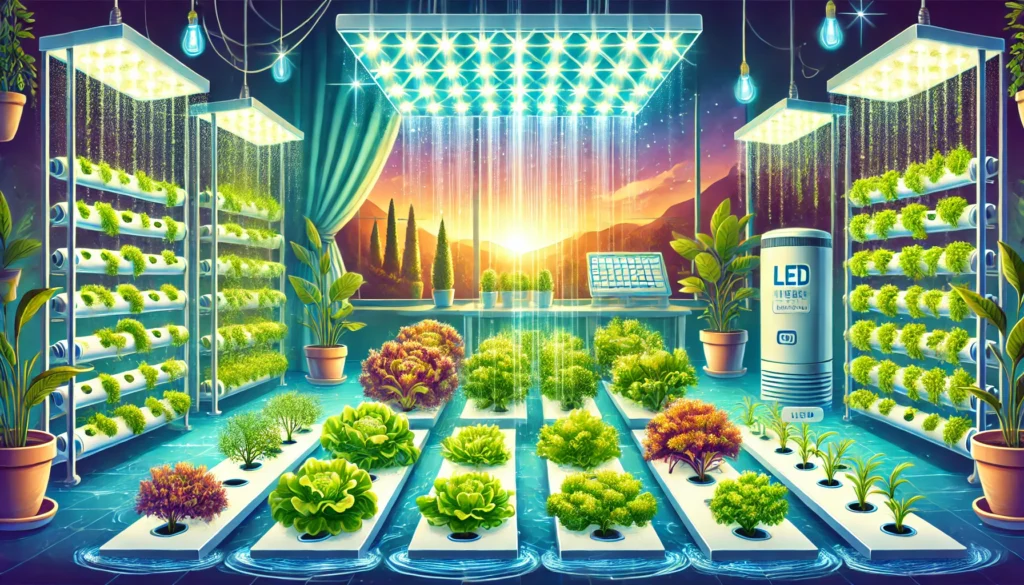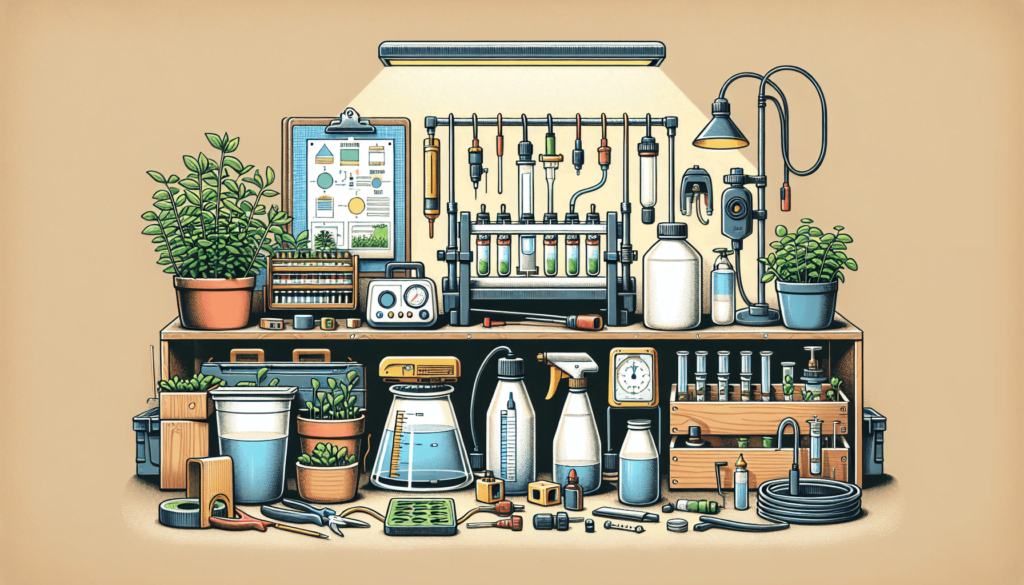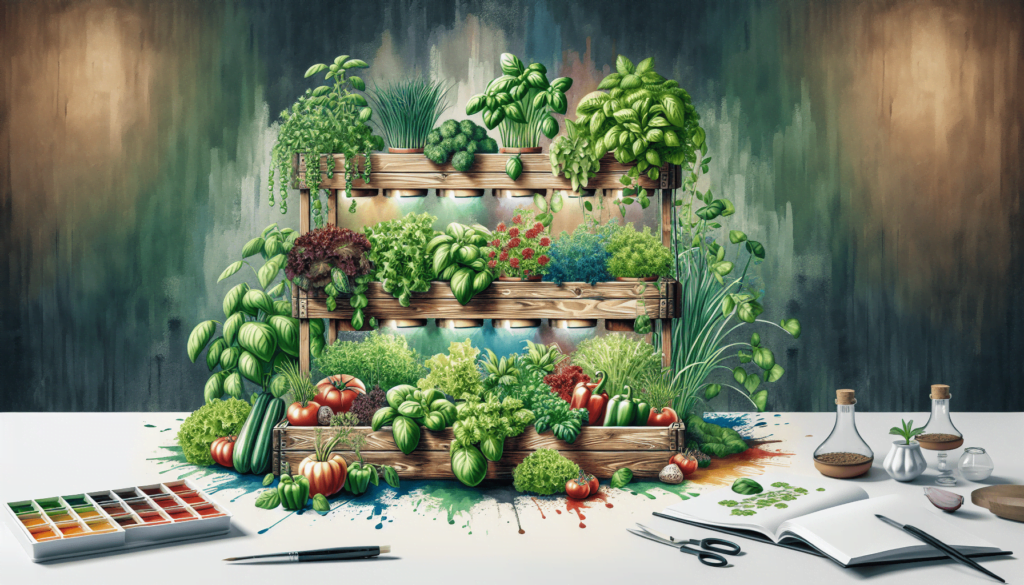Introduction
If you’re just getting started with hydroponics, you might be wondering why lighting is so important. Without the right kind of light, plants can struggle, grow poorly, or not grow at all. In hydroponic gardening, where plants rely on artificial light instead of natural sunlight, choosing the right type of light can make all the difference in whether your plants thrive.
This is where LED grow lights for hydroponics come into play. LED lights are popular with hydroponic gardeners because they are energy-efficient, adjustable, and easy to use. They help make sure your plants get all the light they need to grow well. But what exactly are LED grow lights, and how do you use them effectively?
In this beginner-friendly guide, we’ll explain everything you need to know about using LED lights for indoor gardening, and if you’re interested in exploring other easy hydroponic setups, check out our ultimate guide to Kratky hydroponics—from understanding the basics of LED lights to setting them up for the best plant growth. Let’s explore how the right LED lights can transform your hydroponic garden into a thriving one.
Understanding LED Grow Lights
What Are LED Grow Lights?
LED grow lights are special lights that are designed to provide the type of light plants need for photosynthesis. Unlike regular light bulbs like incandescent or fluorescent ones, LED (Light Emitting Diode) grow lights are more energy-efficient and produce less heat, which makes them perfect for indoor gardens. They are designed to give off the specific colors of light that plants need most, especially blue and red light, which helps plants grow better.
Advantages Over Other Lights
LED grow lights have several benefits compared to traditional types of lighting:
- Energy Efficiency: LEDs use much less electricity than other types of bulbs. This helps keep your electricity bills low, which is important when your plants need light for many hours each day.
- Adjustable Light Spectrum: Many LED grow lights let you change the type of light they give off. You can use more blue light when your plants are growing leaves and more red light when they are flowering. This flexibility helps you meet your plants’ needs at every stage of their life. If you’re curious about how different hydroponic techniques stack up, take a look at our comparison of Deep Water Culture (DWC) vs. Kratky hydroponics.
- Long Life: LED lights last a long time—often up to 50,000 hours or more. This means you won’t need to replace them often, making them a cost-effective option for hydroponic gardening.
Light Spectrum and Plant Growth
Importance of Light Spectrum
The light spectrum is very important for plant growth. Plants need different types of light at different stages of their growth:
- Blue Light (400-500 nm): Blue light helps plants grow strong roots and healthy leaves. It’s especially important for young plants or seedlings.
- Red Light (600-700 nm): Red light helps plants produce flowers and fruits. It tells the plant to switch from growing leaves to flowering.
- Far-Red Light (>700 nm): Far-red light helps control how plants flower and grow taller, but it’s used less often than blue and red light.
Tailoring Light for Hydroponics
In hydroponics, it’s really helpful to be able to adjust the light spectrum. With LED grow lights, you can switch between blue and red light based on what stage your plants are in. This is especially useful indoors, where plants depend completely on artificial light. By using the right kind of light, you can help your plants grow more leaves, flower better, and produce more fruit.
Choosing the Right LED Grow Light for Your Hydroponic Setup
Wattage and Coverage Area
When picking LED grow lights for hydroponics, two things are important: wattage and coverage area.
- Wattage: The wattage tells you how much power the light uses. For small hydroponic gardens, a 200-300 watt LED light is usually enough. For bigger gardens, you’ll need more powerful lights—600 to 1000 watts or more.
- Coverage Area: The coverage area is how much space the light can cover effectively. Make sure you pick a light that can cover the area of your hydroponic garden so that all your plants get enough light.
Understanding PAR and PPFD
There are two important terms to understand when choosing a grow light: PAR and PPFD.
- PAR (Photosynthetically Active Radiation): This is the type of light that plants can use to grow. It usually includes light wavelengths from 400 to 700 nanometers.
- PPFD (Photosynthetic Photon Flux Density): This measures how much PAR light is actually reaching your plants. A higher PPFD value means your plants are getting more intense light, which is important for their growth.
Product Recommendations
For beginners, consider LED grow lights like the Spider Farmer SF-2000 or Mars Hydro TS 1000. These lights are easy to use, save energy, and provide the right mix of blue and red light, making them great for small to medium-sized hydroponic gardens. If you’re still deciding on the best grow light, you might find our guide on troubleshooting hydroponic lighting issues helpful.


Setting Up Your LED Grow Lights
Distance from Plants
How far your LED grow lights are from your plants is very important:
- Seedlings: Keep LED lights about 24-36 inches away from young plants to avoid overwhelming them.
- Vegetative Stage: Once the plants have grown a bit, you can lower the lights to about 18-24 inches to help them grow more leaves and stems.
- Flowering Stage: During flowering, move the lights closer—about 12-18 inches away—to give them the extra light they need to produce flowers and fruit.
Light Timing and Schedules
Plants need different amounts of light depending on their growth stage:
- Seedlings and Vegetative Stage: Give them 16-18 hours of light each day.
- Flowering Stage: Switch to 12 hours of light each day to encourage flowering.
Using an automated timer makes it easy to keep the lights on the right schedule so your plants get the right amount of light every day. To make things even simpler, consider checking out our DIY guide for creating a mini hydroponic system.
Common Mistakes
- Too Close to Plants: If lights are too close, they can cause light burn, which makes the leaves look scorched or bleached.
- Too Far Away: If the lights are too far, the plants may grow too tall and weak as they try to reach the light.
- Wrong Light Schedule: Not adjusting the light schedule for each growth stage can slow down plant growth or stop them from flowering.
Optimizing Light for Different Growth Stages
Seedling Stage
During the seedling stage, give gentle blue light to help the plants develop strong roots and healthy leaves. A lower light intensity works best at this stage.
Vegetative Stage
In the vegetative stage, use more blue light to help the plant grow lots of healthy leaves and stems. This helps your plant get bigger and stronger.
Flowering/Fruiting Stage
For the flowering stage, switch to more red light to help the plant produce flowers and fruits. This helps the plant put its energy into making flowers or vegetables.

Balancing LED Lighting with Other Environmental Factors
Temperature Management
Even though LED lights give off less heat than other types of grow lights, they still add some warmth to your growing area. To keep your plants healthy, try to keep the temperature between 70-80°F (21-27°C) during the vegetative stage. It can be a little cooler during flowering.
- Use fans or an exhaust system to help control the temperature.
- Keep an eye on the temperature with a thermometer, especially if you have several LED lights in your setup.
Humidity and Air Circulation
The light can also affect the humidity in your growing area. Bright light can lower humidity, which is not good for young plants.
- Humidity Levels: Aim for a humidity of 60-70% during the seedling stage. As the plants get bigger, lower it to around 40-50%.
- Air Circulation: Use fans to improve air circulation. This prevents mold and ensures all parts of the plant get enough fresh air. If you’re struggling with keeping the environment balanced, our guide on managing temperature and humidity in hydroponic grow rooms might be just what you need.
Troubleshooting LED Grow Light Issues
Common Problems
- Not Enough Light: If plants are growing slowly, have small leaves, or look pale, they might not be getting enough light.
- Light Burn: Signs of light burn include bleached leaves or brown, crispy edges, which means the lights are too close.
- Uneven Coverage: If some plants look healthier than others, the light might not be spread out evenly.
Signs of Light Problems
- Leggy Plants: If your plants are growing too tall and spindly, they’re probably not getting enough light.
- Scorched Leaves: If the leaves look bleached or have brown spots, the light might be too intense.
Solutions
- Adjust Light Height: Move the lights closer or farther away based on what you see in your plants.
- Increase Light Duration: If the plants look under-lit, you can increase the number of hours the lights are on each day.
- Rotate Plants: Make sure all your plants get even light by rotating them every few days.

Budget-Friendly Tips for Beginners
DIY LED Light Setups
If you’re on a budget, you can create your own DIY LED grow light setup. Buy LED light strips and build a fixture that fits your space. This way, you can save money while still giving your plants the light they need.
Energy Efficiency
One of the great things about using LED lights for indoor gardening is how efficient they are. LEDs turn most of the electricity they use into light, rather than heat, which saves energy. Look for lights that give a lot of lumens (light) for each watt of power they use to make sure you’re getting the most for your money.
Conclusion
Using LED grow lights for hydroponic success can be simple and effective. By learning about the light spectrum, choosing the right light for your garden, and setting up the environment properly, you can create the perfect conditions for your plants to grow. Whether you’re a beginner or just want to get better at hydroponics, LED grow lights are a great way to help your indoor garden thrive.
Don’t be afraid to experiment with different lights and schedules to find out what works best for your plants. If you have questions or want to share your experiences with using LED lights for indoor gardening, leave a comment below. Let’s learn and grow together!
Forum
Got something to share or a question to ask? Jump in and start a conversation! Whether it’s tips, advice, or just sharing your experiences, we’d love to hear from you. Don’t be shy—your input could inspire or help someone else!- This forum has 1 topic, and was last updated 10 months, 2 weeks ago by .
- Topic
- Voices
- Last Post
- You must be logged in to create new topics.



